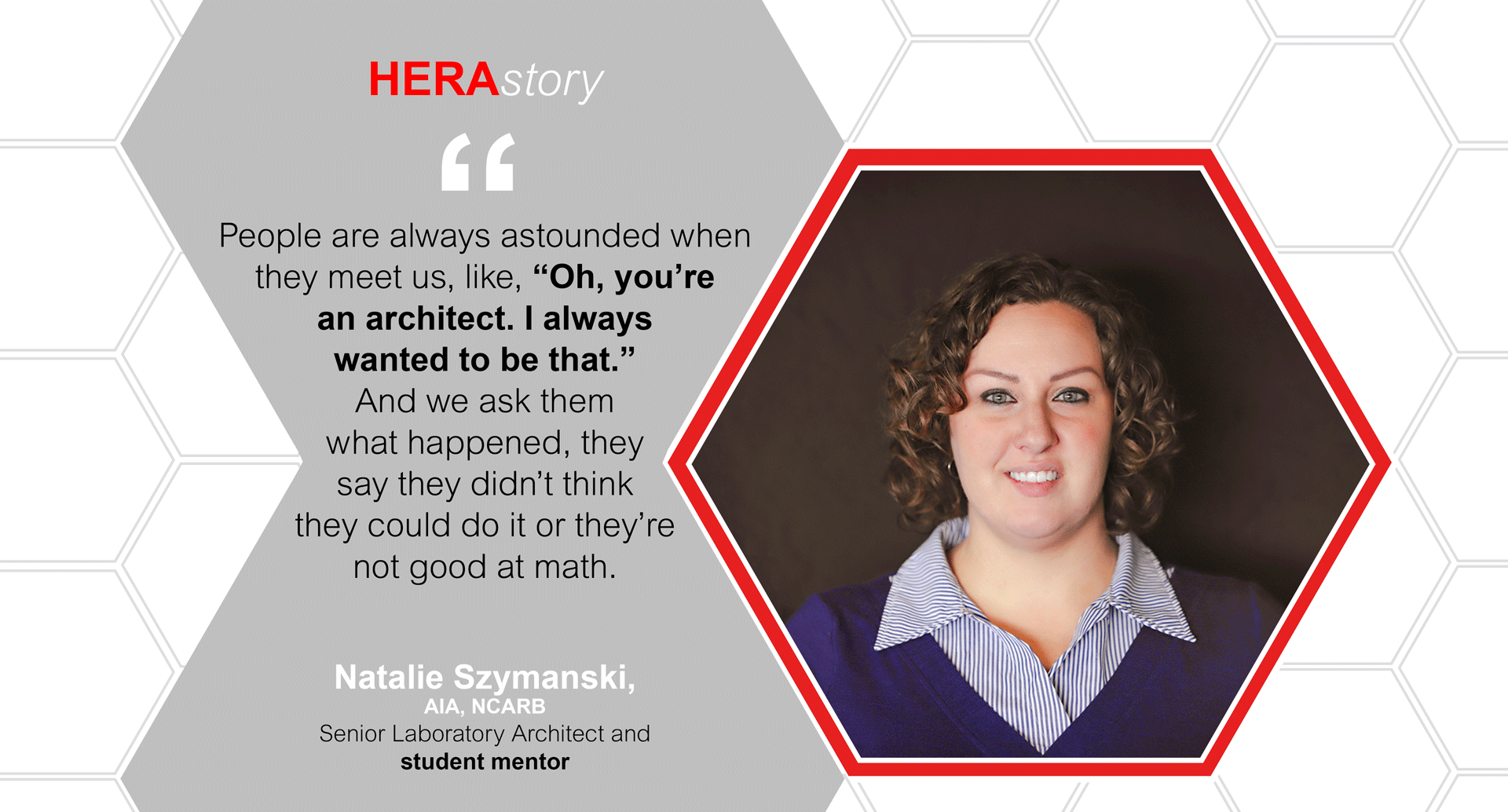Q&A with Senior Laboratory Architect Natalie Szymanski
You’ve been a mentor and teacher on so many different levels. Talk about some of the mentoring work you’re currently doing.
Through the AIA Toledo, I know several architects that I either grew up with or reconnected with after college. Together we decided that there was a lack of information and some misinformation about our field, and we wanted to combat that problem. People are always astounded when they meet us, like, “Oh, you’re an architect. I always wanted to be that.” And we ask them what happened, they say they didn’t think they could do it or they’re not good at math.
The AIA does a great job of promoting the career on their website, but they need people like us to get that information out there further. We each took a section of Northwest Ohio that we live near or had ties to are promoting architecture to students. My section includes three school districts where I’ve either done a career fair or I offer a one-on-one mentorship program. I start with students as young as 9th grade if they’re at all interested in the fields of architecture, engineering and anything in between. We talk about the field, taking the right courses in high school and putting the right things on their resume to get into a NAAB accredited college.
So that’s step one. Step two is the career booth. That’s getting information out there. I promote lab design specifically, trying to get students not just interested in architecture, but to help them see that there’s other types of architecture out there.
So do you have to be good at math to be an architect?
No, you don’t have to be good at math to be an architect! You need a decent understanding of it and you do have to pass your college courses for structures. You do need it when you’re taking your Architect Registration Examination (ARE) to become a registered architect. But that’s algebra, not calculus. You can be good at algebra and not know calculus at all and still ace your exams and be an architect. You don’t have to be some fabulous mathematician. Math is the number one thing I hear. “I’m bad at math. I can’t be an architect.” It’s just not true.
So you’re part myth buster?
Exactly. These are exactly the type of conversations I like having with students. I try to debunk all the myths about architecture and engineering and just give them exposure to what an architect actually does. Nine out of 10 people will tell you that we build things. They don’t understand that it is design related or that you’re a problem solver. They think you have to be a fabulous artist and super creative and all sorts of things. To be a good architect, you need passion, the love for learning and a well-rounded skill set.
When the students get to junior and senior level, we talk about if they really want to be an architect or maybe an engineer or maybe something in the construction trades. I ask them questions like if they want to be on a job site? Do they want to sit behind a desk? I create a rapport with the students and teachers to get more people into the field. If you play the numbers game, the more people you get into the field, the more that’ll stick.
At HERA last summer you helped lead our high school internship program through Rockwood School District in St. Louis, and this year the program was reimagined from previous years.
The AIA puts on a high school design competition in January for scholarship money. Unfortunately, our summer internship doesn’t align with the actual competition, but I used that project for our interns to design. It has a real site, design parameters, zoning issues, a few codes, environmental conditions, things like that that are important considerations for a design project. The students also are tasked with interviewing multiple HERA employees to understand their education, background and experience. This helps explore their options moving forward.
Once the design portion is complete, then we talk to the students about their interest in architecture. We ask them if this summer was what they expected? If yes, let’s talk about colleges and what their futures could look like.
You’re mentoring and training younger staff members as HERA as well, right?
Yes, I train them on specifications and codes and try to help them think about why we do what we do. That’s really important because if you give someone a task, you want them to be more than a robot and just do what they’re told. They need to think about the why. Why is something redlined? Why is what I did not what was wanted? Why is there a better way? How do we know what the better way is? Where do we find the information and the resources?
I take time to try to learn about them and understand their career path, their ideal working situation, what they’re trying to work toward so I can help and be an advocate for them. But it helps me too. I’m constantly learning how to be a better leader, a more effective communicator, a better listener. Those are all things that help with clients, with potential clients, with other coworkers and really in all facets of a career.
This sort of mentoring strengthens the team and the firm. To me, there’s a difference between a boss and a leader. A boss can tell people what to do and have ultimate authority. I don’t necessarily want to be somebody’s boss, but I want to be a leader where I’m inspiring. I want to have a good working relationship with all my coworkers so that any project I’m on is enjoyable and fun and we’re doing great work because we’ve already fostered that relationship through mentorship.
